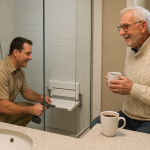When I think about the future, I know one thing for sure—I want to stay in my own home as long as possible. This is known as aging in place. It means living independently in your own home as you grow older. But to make this possible, aging in place remodeling usually becomes necessary.
Benefits of Aging in Place
The emotional benefits of aging in familiar surroundings are huge. Your home holds wonderful memories, comfortable routines, and a sense of belonging that no other place can provide. Additionally, the practical advantages are just as great. You maintain your independence, stay connected to your community, and typically save money when compared to assisted living costs.
Whether you’re planning small adjustments or a full home transformation, this guide walks you through the key areas to consider. I’ll also share practical ideas that support your independence while keeping your home beautiful and functional.
Planning Your Aging in Place Remodeling
“When doing a home assessment, it’s crucial to be completely honest with yourself. Most of us tend to compensate for the smallest of challenges our own homes put in front of us. The problem begins when those challenges increase, or our abilities decline. Our tendency to compensate increases so gradually we may not even notice we are doing it. For this reason it’s a good idea to do an assessment with a family member present or better yet a Certified Aging in Place Specialist”
Before diving into any aging in place remodeling project, you need to start with a thorough assessment. Walk through your home with fresh eyes and look at each room. Consider how you move through your daily routines now and how that might change in the coming years—be brutally honest.
Pay attention to potential problem areas. Are there steps that feel harder to navigate? Do you struggle to reach items in high cabinets? These insights help you set priorities and create a focused remodeling plan.
Involving Your Support Network Early
It’s wise to involve family members, caregivers, or trusted friends in your planning process. They may notice challenges you’ve learned to work around. Additionally, their input can provide valuable perspective on safety concerns and practical solutions.
Consider scheduling a consultation with healthcare professionals as well. Your doctor, physical therapist, or occupational therapist can offer insights into modifications that will best support your specific needs. This collaborative approach ensures your aging in place remodeling addresses both current and future requirements.
The Value of CAPS-Certified Professionals
When selecting a contractor for your aging in place remodeling project, look for someone with CAPS certification. CAPS stands for Certified Aging-in-Place Specialist, and these professionals have specialized training in creating aging-friendly living spaces.
These certified remodelers understand the unique challenges seniors face. They know which modifications provide the most benefit and how to implement them seamlessly. Consequently, working with a CAPS-certified professional can make your aging in place remodeling more effective and stress-free.
Key Risk Zones in Aging in Place Remodeling
Safety should be your top priority in any aging in place remodeling project. Certain areas of your home pose higher risks, and addressing these zones first can prevent accidents and injuries.
Aging in Place Remodeling Priorities by Room
| Room | High-Priority Modifications | Reason for Priority |
|---|---|---|
| Bathroom | Grab bars, non-slip flooring, roll-in shower | High risk of slips and falls |
| Stairways | Lighting, dual handrails, stair lifts | Frequent fall zone for aging adults |
| Kitchen | Lever faucets, pull-out shelving, fire safety | Complex tasks, hot surfaces, sharp tools |
| Entrances | Ramps, motion lights, zero-step thresholds | Key mobility access point |
| Hallways | Wider passages, smooth flooring | Clear path for wheelchairs/walkers |
Bathroom Safety Upgrades
Bathrooms are particularly dangerous for seniors due to wet surfaces and tight spaces. Therefore, bathroom modifications should be high on your aging in place remodeling list.
Install grab bars near the toilet, in the shower, and beside the bathtub. These sturdy supports provide stability when sitting, standing, or moving around wet areas. Choose grab bars rated for at least 250 pounds, and ensure they’re anchored securely into wall studs.
Consider converting your traditional bathtub to a roll-in shower. This eliminates the dangerous step-over required with standard tubs. Walk-in showers with low or no thresholds make bathing safer and more accessible. Additionally, built-in shower seats provide a place to rest while bathing.
Non-slip flooring is crucial throughout the bathroom. Replace smooth tiles with textured surfaces that provide better traction when wet. Also, ensure adequate lighting and consider adding nightlights for safe nighttime navigation.
“When it comes to installing handrails on the staircase, always make sure to turn the handrail in towards a wall or as far from the stairs as possible. An open-ended handrail can hook loose clothing increasing trip and fall risk. This mention is especially important for the DIY folks. This may be part of the building code where you live but regardless, it’s good practice. To be safe, your best bet is to use a licensed installer. ”
Stairway and Hallway Improvements
Stairs present significant fall risks, making them critical areas for aging in place remodeling attention. Improve lighting along stairways with bright, evenly distributed fixtures. Motion-sensor lights can automatically illuminate your path, reducing the risk of missteps.
Install sturdy handrails on both sides of staircases if possible. The handrails should extend beyond the top and bottom steps for added security. Furthermore, ensure the handrails are the proper height and diameter for a comfortable, secure grip.
For those who struggle with stairs there are options. You could consider installing a staircase lift or residential elevator. These systems allow safe access to different levels of your home. While they represent a significant investment, they can be essential for maintaining independence in multi-story homes.
Kitchen Safety and Accessibility
“One danger that’s often overlooked in the kitchen is fire. As we get older, diminished hearing, momentary forgetfulness—or even an unexpected nap—can lead to a burner being left on. I suggest installing appliances with auto shut-off features. It’s a simple safeguard that can make a life-saving difference.”
The kitchen is the heart of most homes, so aging in place remodeling should make this space both safe and functional. Relocate frequently used appliances to counter height to reduce reaching or bending.
Replace traditional faucets with lever-style handles that are easier to operate with limited hand strength or arthritis. These faucets require less grip strength and can be operated with wrists or elbows if necessary.
Install pull-out shelving in lower cabinets to bring items within easy reach. This eliminates the need to bend deeply or crawl into cabinets to retrieve pots, pans, or pet food items. Similarly, consider installing lazy susans in corner cabinets for better access to stored items.
Mobility-Friendly Aging in Place Remodeling Ideas
Creating a mobility-friendly home environment is essential for successful aging in place remodeling. These modifications help you navigate your space safely and comfortably, regardless of mobility changes.
Doorway and Hallway Modifications
Standard doorways are often too narrow for wheelchairs, walkers, or people who need extra space for stability. Widening doorways to at least 36 inches allows easier passage and accommodation of wheelchairs and rollators.
Similarly, hallways should be wide enough for safe navigation. A minimum width of 36 inches is recommended, though 42 inches provides more comfortable passage. This aging in place remodeling modification may require significant construction but can dramatically improve accessibility.
Consider the door hardware as well. Replace round doorknobs with lever-style handles that are easier to operate with limited hand strength or when carrying items. Additionally, ensure doors can be opened with minimal force.
“Creating accessible entrances is critical for aging in place remodeling success. Install ramps where steps currently exist. This typically includes the entrances to the home and the different elevations of the property including the garden. You need to ensure they meet ADA guidelines for slope and safety. For reference the maximum recommended slope is 1:12—meaning one inch of rise for every 12 inches of length.”
Entrance Accessibility Improvements
Threshold-free entrances eliminate tripping hazards and make entry easier for those using mobility aids. These modifications may require adjusting floor levels or installing specialized threshold systems.
Adequate lighting at entrances is essential for safety. Motion-activated lights provide hands-free illumination when approaching your home. Furthermore, consider adding a covered area to provide protection from weather while unlocking doors.
Flooring Considerations for Safety
Flooring plays a crucial role in aging in place remodeling safety. Replace high-pile carpets with low-pile options or smooth flooring materials that are easier to navigate with mobility aids.
However, avoid overly smooth surfaces that can become slippery. Choose flooring with slight texture that provides traction without creating barriers for rollators or walkers. Luxury vinyl plank, certain tile options, and engineered hardwood can provide the right balance of smoothness and traction.
Ensure smooth transitions between different flooring materials. Even small height changes between surfaces can cause tripping or impede mobility devices. Professional installation can ensure these transitions are safe and seamless.
Common Mobility-Friendly Upgrades and Their Benefits
| Upgrade | How It Helps |
|---|---|
| Widened doorways (36”+) | Accommodates wheelchairs and walkers |
| Threshold-free entrances | Eliminates trip hazards |
| Lever-style door handles | Easier to open with limited hand strength |
| Smooth, non-slip flooring | Reduces fall risk and improves movement |
| Motion-activated lighting | Enhances nighttime safety |
Technology and Smart Features for Aging in Place Remodeling
Modern technology offers exciting opportunities to enhance aging in place remodeling projects. Smart home features can improve safety, convenience, and peace of mind for both seniors and their families.
Automated Lighting Solutions
Motion-activated lighting is one of the most valuable additions to any aging in place remodeling project. These lights automatically illuminate your path without fumbling for switches in the dark.
Install motion sensors in hallways, bathrooms, and other frequently traveled areas. The lights should provide adequate illumination without being so bright they’re startling at night. Additionally, consider lights with adjustable sensitivity and timing settings.
Smart lighting systems allow you to control lights remotely or set automatic schedules. You can dim lights gradually in the evening or ensure outdoor lights turn on before you arrive home. These systems can be controlled through smartphone apps or voice commands.
Voice-Controlled Smart Home Assistants
Voice-controlled assistants can be invaluable tools in aging in place remodeling strategies. These devices allow you to control lights, thermostats, and other connected devices without physical interaction.
You can ask your voice assistant to call family members, set medication reminders, or even request emergency assistance. Additionally, these devices can provide weather updates, news, and entertainment without requiring you to operate complex electronics.
Smart assistants can also control other connected devices throughout your home. Adjust the thermostat, lock doors, or check security cameras using simple voice commands. This technology becomes particularly valuable if mobility or dexterity challenges make operating traditional controls difficult.
Advanced Safety and Monitoring Systems
Smart thermostats offer both comfort and safety benefits in aging in place remodeling. They maintain consistent temperatures automatically and can be programmed or adjusted remotely. Some models can even detect when you’re away and adjust accordingly to save energy.
Fall-detection systems provide an additional layer of safety for aging in place. These devices can automatically detect if you’ve fallen and cannot get up, then alert family members or emergency services. Some systems use wearable devices, while others use sensors placed throughout the home.
Video doorbells allow you to see and speak with visitors without opening the door. This technology enhances security and allows you to screen visitors safely. Additionally, family members can check on you remotely if you don’t answer phone calls.
Smart Home Features That Support Aging in Place
| Smart Feature | Benefit |
|---|---|
| Motion-activated lighting | Prevents falls at night |
| Voice assistants | Hands-free control and emergency contact |
| Smart thermostats | Maintains comfort and saves energy |
| Fall-detection systems | Alerts family or emergency services |
| Video doorbells | Screen visitors and enhance security |
Comfort Upgrades Make a Difference in Aging in Place Remodeling
Comfort modifications can significantly improve your daily life and make aging in place more enjoyable. These upgrades focus on reducing strain and making routine activities easier and more pleasant.
Adjustable and Accessible Work Surfaces
Installing adjustable-height counters in your kitchen can accommodate different tasks and physical needs. These surfaces can be raised for food preparation while standing or lowered for seated work. This flexibility is ideal for seated tasks or wheelchair users.
Consider adding a kitchen island or peninsula with adjustable height capabilities. This provides additional workspace that can be customized to your needs. Furthermore, ensure adequate knee space underneath for comfortable seated use.
In bathrooms, adjustable-height vanities can make daily grooming tasks more comfortable. These modifications allow you to customize the height for optimal comfort and accessibility. Additionally, ensure adequate lighting and storage at the new height level.
Bathroom Comfort Enhancements
Comfort-height toilets, also known as ADA-compliant toilets, are taller than standard models. This extra height makes sitting down and standing up easier and less strenuous. The standard comfort height is 17-19 inches compared to 14-15 inches for regular toilets.
Accessible vanities should have adequate knee space underneath for seated use. The countertop should be at a comfortable height for both standing and seated users. Additionally, consider installing pull-out drawers instead of traditional cabinets for easier access to stored items.
Install adequate lighting around mirrors and vanity areas. Good lighting is essential for grooming activities and can help prevent accidents. Consider adding side lighting to reduce shadows on your face while using the mirror.
Environmental Comfort Systems
Soundproofing can significantly improve comfort in your aging in place remodeling project. As we age, we often become more sensitive to noise, and a quieter home environment can improve sleep quality and overall well-being.
Temperature regulation becomes increasingly important with age. Ensure your heating and cooling systems can maintain consistent, comfortable temperatures throughout your home. Consider adding zone controls to adjust temperatures in different areas according to your preferences and usage patterns.
Improved ventilation helps maintain good air quality and comfort. Ensure bathrooms and kitchens have adequate exhaust fans to remove moisture and odors. Additionally, consider adding air purification systems if you have respiratory sensitivities or allergies.
Budgeting and Funding Your Aging in Place Remodeling Project
Understanding the financial aspects of aging in place remodeling helps you plan effectively and make informed decisions about which modifications to prioritize.
Set Realistic Priorities
Start by listing all desired modifications and ranking them by importance and urgency. Safety improvements should typically take priority over convenience or aesthetic upgrades. Additionally, consider which modifications provide the most significant impact on your daily life and independence.
Create a realistic timeline for your aging in place remodeling project. Some modifications can be completed quickly and inexpensively, while others require significant planning and investment. Phasing your project over time can make it more financially manageable.
Consider your current needs versus anticipated future needs. While it’s wise to plan ahead, avoid over-improving for situations that may never arise. Focus on modifications that will benefit you now while providing flexibility for future adaptations.
Understand Medicare and Insurance Limits
Unfortunately, Medicare and most health insurance plans have limited coverage for aging in place remodeling projects. These programs typically only cover modifications deemed medically necessary and prescribed by a physician.
Medicare may cover some durable medical equipment like grab bars or shower chairs, but generally won’t pay for structural modifications like widening doorways or installing ramps. However, check with your specific insurance provider about coverage for medically necessary modifications.
Some Medicare Advantage plans may include home safety modifications. Review your plan details or speak with a representative to understand what might be covered under your specific policy.
Explore Grants, Loans, and Tax Credits
Many states and local communities offer grants or low-interest loans for aging in place remodeling projects. These programs are often income-based and designed to help seniors remain in their homes safely.
The USDA Rural Development program offers grants and loans for home improvements in rural areas. Similarly, some utility companies provide rebates for energy-efficient upgrades that might be part of your aging in place remodeling project.
Tax credits may be available for certain accessibility improvements. The federal government and some states offer tax incentives for installing accessibility features. Consult with a tax professional to understand which modifications might qualify for credits or deductions.
Recognizing it’s Time for Aging in Place Remodeling
Knowing when to begin your aging in place remodeling project can help you stay ahead of challenges rather than reacting to crises.
Signs and Indicators
If you find yourself struggling with stairs, avoiding certain areas of your home, or feeling unsteady in bathrooms, it’s time to consider aging in place remodeling. These challenges often develop gradually, making them easy to ignore until they become serious safety concerns.
Recent falls or near-falls are clear indicators that modifications are needed. Don’t wait for a serious injury to prompt action. Additionally, if you’re relying increasingly on walls or furniture for support while walking, grab bars or other support features should be installed right away.
Changes in vision, hearing, or cognitive function may require different types of modifications. Improved lighting, visual contrast, and simplified controls can help you navigate these changes successfully while maintaining independence.
Anticipating Future Needs
Proactive aging in place remodeling is more effective and less expensive than emergency modifications. Consider your family medical history and discuss potential future needs with your healthcare providers.
If you have conditions that typically progress over time, plan modifications that will accommodate these changes. For example, if you have early-stage arthritis, installing lever-style door handles now can prevent future struggles with traditional doorknobs.
Consider the experiences of friends or family members who have aged in place successfully or unsuccessfully. Their experiences can provide valuable insights into which modifications are most beneficial and which challenges you might face.
Professionals and Aging in Place Remodeling
Selecting the right professionals can make the difference between a successful aging in place remodeling project and one that falls short of your needs.
Choosing Specialized Contractors
Aging-in-place specialists have specific training and experience that general contractors may lack. These professionals understand the unique requirements of senior-friendly design and can suggest modifications you might not have considered.
CAPS-certified remodelers have completed specialized training in aging-in-place concepts and solutions. They understand building codes related to accessibility and can ensure your modifications meet current standards. Additionally, they often have experience working with seniors and understand the sensitivity required for these projects.
Look for contractors who can provide references from previous aging in place remodeling projects. Speak with these references about their experience, the quality of work, and how well the modifications met their needs.
What to Expect from Professional Consultations
A good aging in place remodeling consultation should include:
- A thorough assessment of your current home and discussion of your specific needs and concerns.
- The professional should ask about your daily routines, mobility challenges, and future expectations.
- A detailed proposal that includes specific modifications, materials, timeline, and costs.
- The proposal should explain how each modification addresses your stated needs and concerns.
- It should include information about permits, inspections, and cleanup.
- Consultations should also include discussion of maintenance requirements for new installations.
- An understanding of how to care for grab bars, ramps, or other modifications ensures they continue to provide safety and functionality over time.
Ensuring Quality and Style
Your aging in place remodeling project shouldn’t result in a clinical or institutional appearance. Good professionals can incorporate safety and accessibility features while maintaining the attractive, homelike atmosphere you value.
Discuss your style preferences and how modifications can complement your existing décor. Many accessibility features are now available in attractive designs that blend seamlessly with home décor. Additionally, professional installation ensures modifications look integrated, not like afterthoughts.
Quality installation is crucial for both safety and appearance. Ensure your contractor provides warranties on both materials and workmanship. Additionally, verify that all work will be completed according to local building codes and permit requirements.
The Future of Aging in Place Remodeling
Successful aging in place remodeling creates a home that grows and adapts to your changing needs while maintaining the comfort and beauty you cherish.
The key to effective aging in place remodeling lies in thoughtful planning that balances current needs with future flexibility. Your modifications should enhance your daily life now while providing a foundation for additional adaptations if needed later.
“Remember that aging in place remodeling doesn’t mean turning your home into a medical facility.”
Today’s accessibility features can be beautiful, functional, and seamlessly integrated into your existing home design. The goal is creating a space that supports your independence while reflecting your personal taste and lifestyle.
I encourage you to begin planning your aging in place remodeling project sooner rather than later. Proactive changes are more thoughtful, affordable, and less disruptive than reactionary changes made after a crisis situation. Early planning also allows you to research your options thoroughly and make decisions at your own pace.
Final Thoughts
Your home has been your sanctuary throughout your life, and with thoughtful aging in place remodeling, it can continue to provide safety, comfort, and independence for years to come. The investment in these modifications pays dividends in peace of mind, continued independence, and the joy of remaining in the place you love most.
Start your aging in place remodeling journey today by assessing your current needs and envisioning your future requirements. With proper planning and the right professional support, you can create a home that truly adapts with you, ensuring your independence and safety for years to come.






